沪教版小学英语六年级上册教案
- 格式:docx
- 大小:13.73 KB
- 文档页数:11
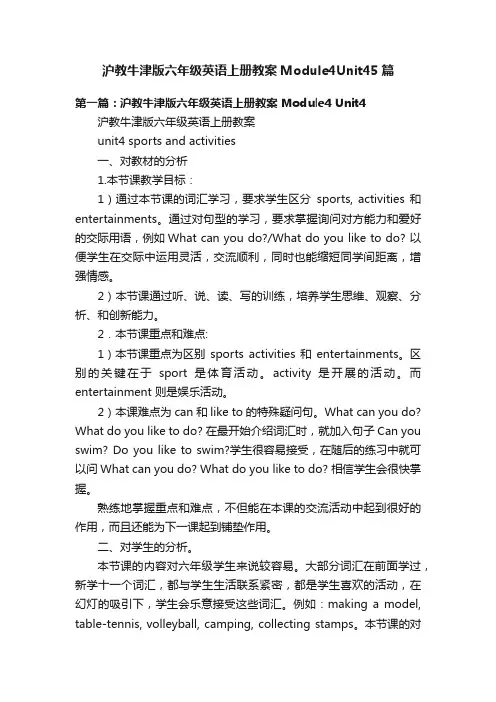
沪教牛津版六年级英语上册教案Module4Unit45篇第一篇:沪教牛津版六年级英语上册教案 Module4 Unit4 沪教牛津版六年级英语上册教案unit4 sports and activities一、对教材的分析1.本节课教学目标:1)通过本节课的词汇学习,要求学生区分sports, activities 和entertainments。
通过对句型的学习,要求掌握询问对方能力和爱好的交际用语,例如What can you do?/What do you like to do? 以便学生在交际中运用灵活,交流顺利,同时也能缩短同学间距离,增强情感。
2)本节课通过听、说、读、写的训练,培养学生思维、观察、分析、和创新能力。
2.本节课重点和难点:1)本节课重点为区别sports activities和entertainments。
区别的关键在于sport是体育活动。
activity是开展的活动。
而entertainment 则是娱乐活动。
2)本课难点为can 和like to的特殊疑问句。
What can you do? What do you like to do? 在最开始介绍词汇时,就加入句子Can you swim? Do you like to swim?学生很容易接受,在随后的练习中就可以问What can you do? What do you like to do? 相信学生会很快掌握。
熟练地掌握重点和难点,不但能在本课的交流活动中起到很好的作用,而且还能为下一课起到铺垫作用。
二、对学生的分析。
本节课的内容对六年级学生来说较容易。
大部分词汇在前面学过,新学十一个词汇,都与学生生活联系紧密,都是学生喜欢的活动,在幻灯的吸引下,学生会乐意接受这些词汇。
例如:making a model, table-tennis, volleyball, camping, collecting stamps。
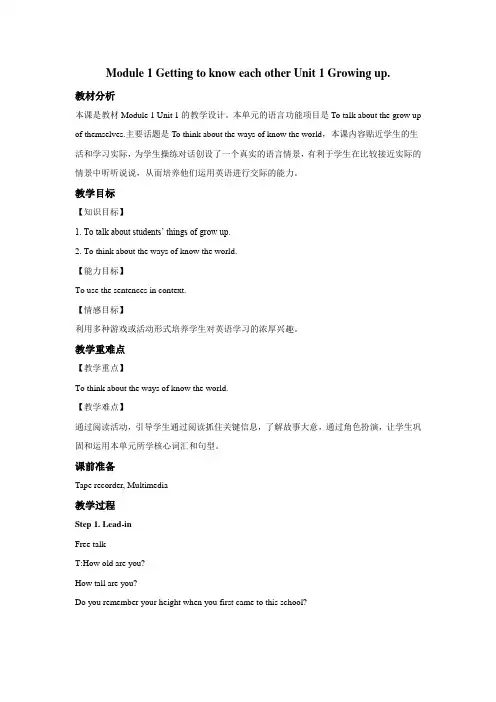
Module 1 Getting to know each other Unit 1 Growing up.教材分析本课是教材Module 1 Unit 1的教学设计。
本单元的语言功能项目是To talk about the grow up of themselves.主要话题是To think about the ways of know the world,本课内容贴近学生的生活和学习实际,为学生操练对话创设了一个真实的语言情景,有利于学生在比较接近实际的情景中听听说说,从而培养他们运用英语进行交际的能力。
教学目标【知识目标】1. To talk about students’ things of grow up.2. To think about the ways of know the world.【能力目标】To use the sentences in context.【情感目标】利用多种游戏或活动形式培养学生对英语学习的浓厚兴趣。
教学重难点【教学重点】To think about the ways of know the world.【教学难点】通过阅读活动,引导学生通过阅读抓住关键信息,了解故事大意,通过角色扮演,让学生巩固和运用本单元所学核心词汇和句型。
课前准备Tape recorder, Multimedia教学过程Step 1. Lead-inFree talkT:How old are you?How tall are you?Do you remember your height when you first came to this school?Step 2. Listen and readPlay the tape for students to listen and answer.Ask the students to listen to the comic strips and answer the following questions:1.What is on Eddie’s mind?2.Will Eddie build his house by himself?Step 3. PresentationT:You are growing older and taller, so ,you are growing up.What comes into your mind when talking about “growing up”?Encourage the students to talk about the words or sentences about “growing up”?Q: Do you feel happy to grow up?Do you want to grow up?Teacher says: Just like what Eddie said,“Growing up is hard.”Growing up also means that you learn more about the world.How do you learn about the world?Show them some pictures to encourage the students to say out the full sentences and finish Part A.Step 4. PracticeListen to part B.Ask: How does Mill learn about the world? Why?How does Simon learn about the world? Why?Work in pairs to practice the dialogue.Sample conversation :S1:How do you learn about the world?S2:I like to learn about the world from films.S1:Why do you like to learn that way?S2:Because I can see...Step 5. SummaryDiscussion: What have we learned in this class?Show time.1.on one’s mind.2.be worried about(doing).3.Growing up is hard.4.You have been happy since I first met you.5.wake sb. up.6.learn that way.7.through the Internet.8.as soon as.9.a great deal of.Step 6. HomeworkRevise the contents we’ve learned in this period .Recite the comic strip fluently .Finish exercises in workbook for each period.Unit 2 My summer holiday【第一课时】【教学目标】1.帮助学生学习Look and learn中的生词。
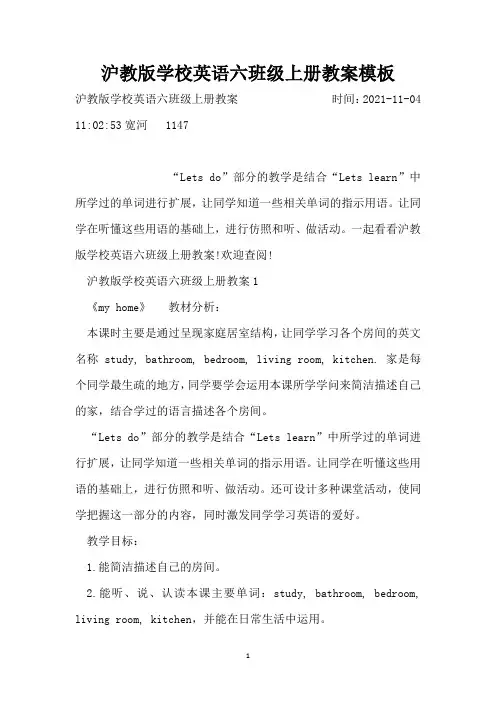
沪教版学校英语六班级上册教案模板沪教版学校英语六班级上册教案时间:2021-11-04 11:02:53宽河 1147“Lets do”部分的教学是结合“Lets learn”中所学过的单词进行扩展,让同学知道一些相关单词的指示用语。
让同学在听懂这些用语的基础上,进行仿照和听、做活动。
一起看看沪教版学校英语六班级上册教案!欢迎查阅!沪教版学校英语六班级上册教案1《my home》教材分析:本课时主要是通过呈现家庭居室结构,让同学学习各个房间的英文名称study, bathroom, bedroom, living room, kitchen. 家是每个同学最生疏的地方,同学要学会运用本课所学学问来简洁描述自己的家,结合学过的语言描述各个房间。
“Lets do”部分的教学是结合“Lets learn”中所学过的单词进行扩展,让同学知道一些相关单词的指示用语。
让同学在听懂这些用语的基础上,进行仿照和听、做活动。
还可设计多种课堂活动,使同学把握这一部分的内容,同时激发同学学习英语的爱好。
教学目标:1.能简洁描述自己的房间。
2.能听、说、认读本课主要单词:study, bathroom, bedroom, living room, kitchen,并能在日常生活中运用。
3.能听懂Lets do中的指示语,并依据指令作出相应的动作。
教学重点:1、听、说、认读单词:study, bathroom, living room, bedroom, kitchen。
2、学习表示指令的词组。
教学难点:单词study, bathroom, bedroom的发音。
教学方法:引导法启发法直观教学法学法分析:小组合作学习法争辩学习法自主学习法教学过程:1 Warm-up/Revision老师引导1、集体唱英文儿歌。
2、复习上节课所学单词2 Presentation1、出示study 的图片,手指着书房里的书问同学:What are they? 教读单词 study, 并板书。
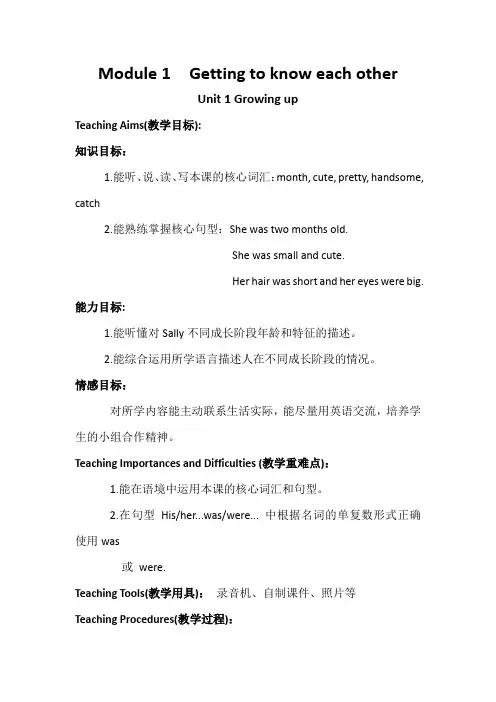
Module 1 Getting to know each otherUnit 1 Growing upTeaching Aims(教学目标):知识目标:1.能听、说、读、写本课的核心词汇:month, cute, pretty, handsome, catch2.能熟练掌握核心句型:She was two months old.She was small and cute.Her hair was short and her eyes were big.能力目标:1.能听懂对Sally不同成长阶段年龄和特征的描述。
2.能综合运用所学语言描述人在不同成长阶段的情况。
情感目标:对所学内容能主动联系生活实际,能尽量用英语交流,培养学生的小组合作精神。
Teaching Importances and Difficulties (教学重难点):1.能在语境中运用本课的核心词汇和句型。
2.在句型His/her...was/were... 中根据名词的单复数形式正确使用was或were.Teaching Tools(教学用具):录音机、自制课件、照片等Teaching Procedures(教学过程):StepⅠ.Warm up and revision(热身与复习)1. Greetings.2. Do some warming-up exercises.3. Review the numbers.Step Ⅱ.Presentation and practice(呈现新语言知识和练习)1. Lead in.T: How old are you?S1: I’m eleven years oldT: You’ll be twelve years old next year. You’re growing up.2. Show some photos and introduce the new words.3. Learn to say and use the words.4. Talk about the photos of Sally.5. Watch the screen and learn to say the sentences.6. Ask pupils to practise in groups.Sept Ⅲ. Learn the story (学习课文)1. Read the story and learn to say the useful sentences.2. Watch the cartoon.Module 1 Getting to know each otherUnit 2 My summer holidayTeaching Aims(教学目标):1.能听、说、读、写本课的核心词汇:famous, during, spend, everyone,countryside2.能熟练掌握核心句型:How was your summer holiday?It was wonderful. We went to the Great Wall.Everyone had a good time.3.读懂有关暑假生活的对话,学会询问别人和介绍自己的暑假生活。
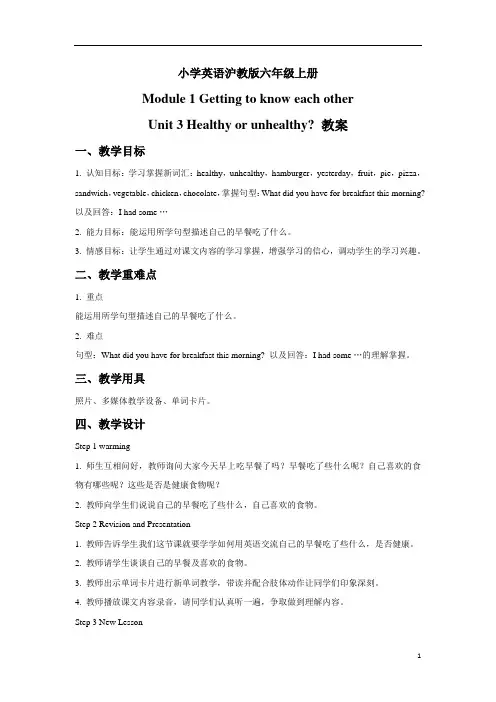
小学英语沪教版六年级上册Module 1 Getting to know each otherUnit 3 Healthy or unhealthy? 教案一、教学目标1. 认知目标:学习掌握新词汇:healthy,unhealthy,hamburger,yesterday,fruit,pie,pizza,sandwich,vegetable,chicken,chocolate,掌握句型:What did you have for breakfast this morning? 以及回答:I had some …2. 能力目标:能运用所学句型描述自己的早餐吃了什么。
3. 情感目标:让学生通过对课文内容的学习掌握,增强学习的信心,调动学生的学习兴趣。
二、教学重难点1. 重点能运用所学句型描述自己的早餐吃了什么。
2. 难点句型:What did you have for breakfast this morning? 以及回答:I had some …的理解掌握。
三、教学用具照片、多媒体教学设备、单词卡片。
四、教学设计Step 1 warming1. 师生互相问好,教师询问大家今天早上吃早餐了吗?早餐吃了些什么呢?自己喜欢的食物有哪些呢?这些是否是健康食物呢?2. 教师向学生们说说自己的早餐吃了些什么,自己喜欢的食物。
Step 2 Revision and Presentation1. 教师告诉学生我们这节课就要学学如何用英语交流自己的早餐吃了些什么,是否健康。
2. 教师请学生谈谈自己的早餐及喜欢的食物。
3. 教师出示单词卡片进行新单词教学,带读并配合肢体动作让同学们印象深刻。
4. 教师播放课文内容录音,请同学们认真听一遍,争取做到理解内容。
Step 3 New Lesson活动Let’s do a survey教师制作一张表格,请同学们分别填上自己三餐所吃的食物,并在表格完成后请一位同学向其他同学介绍任意一位同学的三餐吃了什么,并评价是否健康。
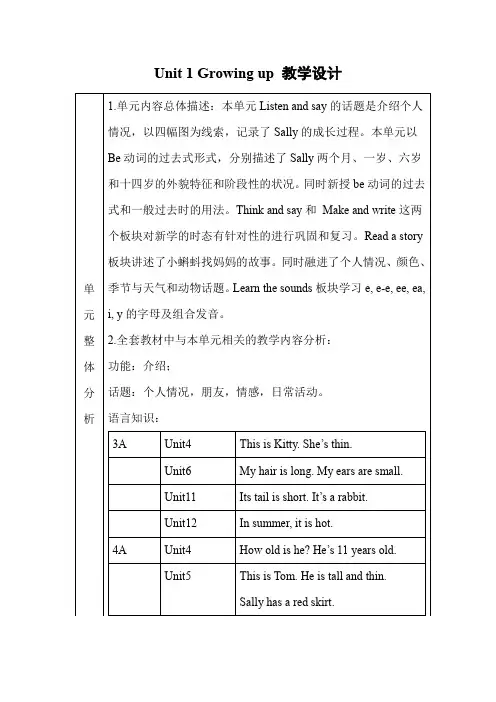
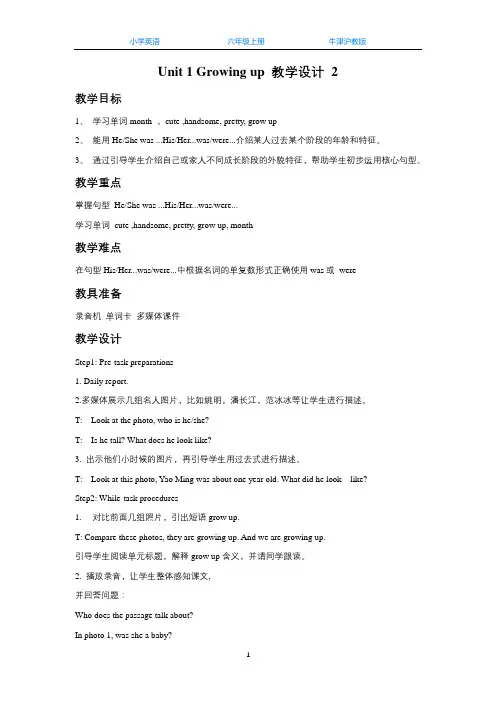
Unit 1 Growing up 教学设计2教学目标1、学习单词month ,cute ,handsome, pretty, grow up2、能用He/She was ...His/Her...was/were...介绍某人过去某个阶段的年龄和特征。
3、通过引导学生介绍自己或家人不同成长阶段的外貌特征,帮助学生初步运用核心句型。
教学重点掌握句型He/She was ...His/Her...was/were...学习单词cute ,handsome, pretty, grow up, month教学难点在句型His/Her...was/were...中根据名词的单复数形式正确使用was或were教具准备录音机单词卡多媒体课件教学设计Step1: Pre-task preparations1. Daily report.2.多媒体展示几组名人图片,比如姚明,潘长江,范冰冰等让学生进行描述。
T: Look at the photo, who is he/she?T: Is he tall? What does he look like?3. 出示他们小时候的图片,再引导学生用过去式进行描述。
T: Look at this photo, Yao Ming was about one year old. What did he look like?Step2: While-task procedures1. 对比前面几组照片,引出短语grow up.T: Compare these photos, they are growing up. And we are growing up.引导学生阅读单元标题,解释grow up含义,并请同学跟读。
2. 播放录音,让学生整体感知课文,并回答问题:Who does the passage talk about?In photo 1, was she a baby?In photo 2, was her hair long or short?In photo 3, how old was she?Now what does she look like?3. ①出示课件一:让学生用过去式描述Sally两个月时的照片。
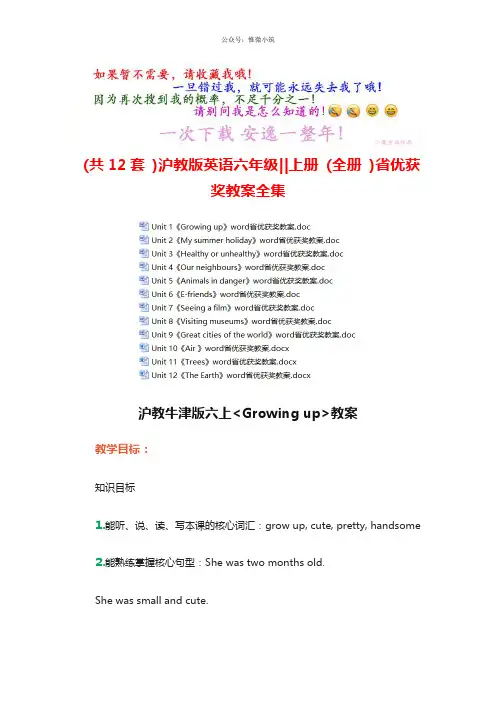
(共12套)沪教版英语六年级||上册(全册)省优获奖教案全集沪教牛津版六上<Growing up>教案教学目标:知识目标1.能听、说、读、写本课的核心词汇:grow up, cute, pretty, handsome2.能熟练掌握核心句型:She was two months old.She was small and cute.Her hair was short and her eyes were big.能力目标1.能听懂对Sally不同成长阶段年龄和特征的描述.2.能综合运用所学语言描述人在不同成长阶段的情况.情感目标对所学内容能主动联系生活实际,能尽量用英语交流,培养学生的小组合作精神.重点难点:1.能在语境中运用本课的核心词汇和句型.2.在句型His/her...was/were... 中根据名词的单复数形式正确使用was 或were.教学用具:录音机、自制课件、照片等教学过程:StepⅠWarm up and revision (热身与复习)1. Greetings.2. Do some warming -up exercises.3. Review the numbers.Step ⅡPresentation and practice (呈现新语言知识和练习) 1. Lead in.T: How old are you?S1: I ,m eleven years oldT: You ,ll be twelve years old next year. You ,re growing up.2. Show some photos and introduce the new words.3. Learn to say and use the words.4. Talk about the photos of Sally.5. Watch the screen and learn to say the sentences.6. Ask pupils to practise in groups .Sept ⅢLearn the story (学习课文)1. Read the story and learn to say the useful sentences.2. Watch the cartoon.牛津版六上<My summer holiday>教案教学目标:1.能听、说、读、写本课的核心词汇:famous, during,spend, everyone,countryside2.能熟练掌握核心句型:How was your summer holiday?It was wonderful. We went to the Great Wall.Everyone had a good time.3.读懂有关暑假生活的对话,学会询问别人和介绍自己的暑假生活.重点难点:1.能在语境中正确运用本单元的核心词汇和句型.2.能写几句话简单描述自己的暑假生活.3.在具体的情境中正确运用一般现在时和一般过去时.4.了解字母e、a及字母组合ea在单词中的发音规律,拼读简单的单词.教学用具:录音机、自制课件、照片等教学过程:StepⅠWarm up and revision (热身与复习)1. Greetings.2. Do some warming -up exercises.Step ⅡPresentation and practice (呈现新语言知识和练习) 1. Lead in.T: Do you like the summer holiday or winter holiday?How was your summer holiday?S1: It was wonderful.T: Where did you go?Ss: I went to Beijing.2. Show some pictures and introduce Beijing.3. Learn to say and write the phrases.4. Read and spell the words.5. Choose and say:This is the Great Wall. It ,s in Beijing.6. Watch the screen and learn to say the useful sentences.How was your summer holiday?It was wonderful. We went to the Great Wall.7. Ask pupils to practise in groups .Sept ⅢLearn the story (学习课文)1. Watch the cartoon.2. Students follow the recording and repeat the dialogues.3. The pupils read the text carefully. And then try to do some exercises.Step ⅣConsolidation (拓展延伸)The pupils learn to write something about their summer holidays.牛津版六上<Healthy or unhealthy>教案教学目标:1.能听、说、读、写本课的核心词汇healthy,unhealthy,hamburger,fruit,pie,pizza,sandwich,vegetables,chicke n,chocolate,a little2.能熟练掌握核心句型- -What did you have for breakfast this morning?- -I had some bread and milk.重点难点:1.能在语境中运用本课的核心词汇和句型.2.能正确理解和运用a lot of, some, a little表达物品的数量.教学用具:录音机、自制课件、照片等教学过程:StepⅠWarm up and revision (热身与复习)1. Greetings.2. Talk about the food.StepⅡPresentation and practice (呈现新语言知识和练习)1. Lead in.T: What did you have for breakfast this morning?Ss: I had some milk/some bread/an egg.2. Learn to say and use the words.T: Look at the pictures. What ,s this?Ss: It ,s a hamburger.3. Read and spell the new words.4. Watch the screen and learn to say the sentences.5. Ask pupils to practise in groups .6. Talk and share.Sept ⅢLearn the story (学习课文)1. Read the story and learn to say the useful sentences.2. Watch the cartoon.3. Students follow the recording to read the story.4. The pupils read the text carefully. And then try to answer the questions.5. Ask the children to play in roles.Step ⅣConsolidation (拓展延伸)Do a survey. And complete the table.教学反思:通过学习,学生们能分辨出健康和不健康的饮食和生活习惯,他们知道了早餐的重要性,健康饮食习惯的重要性.牛津版六上<Our neighbours>教案教学目标:1.能听、说、读、写本课的核心词汇:neighbour, son, daughter, noisy,dig, make a noise2.能熟练掌握核心句型:Did you play with Sam last weekend?Yes, I did.Do you know them?3.询问别人邻居的情况及邻里关系,体会邻里关系的重要性.重点难点:1.能在语境中正确运用本单元的核心词汇.2.能用Do you…?和Did you…?询问别人和邻居的相处情况.3.在句型Did you…?中动词用原型.4.了解字母a,u,o及字母组合ar在单词中的发音规律,拼读简单的单词.教学用具:录音机、自制课件、照片等教学过程:StepⅠWarm up and revision (热身与复习)1. Greetings.2. Play a game : quick eyesStepⅡPresentation and practice (自主探究)1.生词关T: Please write the meanings on your paperneighbour ______ son______ daughter________ writer________weekend______ play chess_________ The Greens__________ The Wus_________2. T:Show the pictures,learn the new words: neighbour/daughterSs:read these words after teacher.3. Work in groups to read the new words. Recite the new words, then recite in groups.4. Watch the screen and learn to say the sentences.5. Ask pupils to practise in groups .Sept ⅢLearn the story (学习课文)1、自读课文,找出不会读的单词或不理解的地方,用笔圈出来.2、听录音,跟读两遍. (要注意语音语调哦! )3、组内交流,翻译句子,然后对子互查.4、我会总结本课的重点句型.Step ⅣShow (展示交流)选择自己喜欢的内容展示.Task1: 识记单词和短语.Task2: 句型讲解.Task3:熟练地朗读课文并尝试背诵.Task4: 用所学句型创编对话. (能创设情景的,要额外加分哦!你还还可以用自己喜欢的内容展示哟! )教学反思:本节课上,让学生当小老师教单词,大家注意力集中,学得积极快乐. 把课堂的主动权还给孩子,能激发学生的求知欲.牛津版六上<Animals in danger>教案教学目标:1.能听、说、读、写本课的核心词汇:thousand, hundred, wild,way, die, learn, send, in danger, in the past, take care of2.能熟练掌握核心句型:In the past, there were many pandas.What can we do to help them?3.知道动物是人类的朋友,人类应该和动物建立良好的关系,要保护动物.重点难点:1.能在语境中正确运用本单元的核心词汇.2.用There was/were …对某种东西的数量进行陈述.3.了解字母u及字母组合ue、oo在单词中的发音规律,拼读简单的单词.教学用具:录音机、自制课件、照片等教学过程:StepⅠWarm up and revision (热身与复习)1. Sing a song.2. Play a game : Apple tree3. Count the numbers together.Step ⅡPresentation and practice (自主探究)1.生词关T: Please write the meanings on your paperthousand______ hundred______ wild________ only________ about______ whale _________ am/is_______ (过去式) are______ (过去式)2. T:Show the pictures and learn the new words: thousand, hundredSs:read these words after teacher.3. Work in groups to read the new words. Recite the new words, then recite in groups.4. Watch the screen and learn to say the sentences.There was/were….5. Ask pupils to practise in groups .Sept ⅢLearn the story (学习课文)1、自读课文,找出不会读的单词或不理解的地方,用笔圈出来.2、听录音,跟读两遍.3、组内交流,翻译句子,然后对子互查.4、我会总结本课的重点句型.5.做31页练习题:Circle the corret answer.Step ⅣShow (展示交流)选择自己喜欢的内容展示.Task1: 识记单词和短语.Task2: 句型讲解.Task3:熟练地朗读课文并尝试背诵.教学反思:本节课,大局部学生能听说读写核心单词、核心句型. Listen and say局部课文长,句子长,有的学生读得不流利,下节课前还需要再稳固复习.牛津版六上<E -friends>教案教学目标:1.能听、说、读、写本课的核心词汇:e -friend, country, other ,hobby, would like2.能熟练掌握核心句型:Would you like to have e -friends in other countries?I ,d like to know about…Please write back soon.3.运用英语知识结识外国笔友,体会用英语交流的乐趣.重点难点:1.能在语境中正确运用本单元的核心词汇.2.能用Would you like to…? I ,d like to…询问和表达愿望.教学用具:录音机、自制课件、照片等教学过程:StepⅠWarm up and revision (热身与复习)1. Sing a song:All animals are bright and beautiful.2. Talk about families and relatives.Step ⅡPresentation and practice (自主探究)1.生词关T: Please write the meanings on your paperother______ country______ e -friend________favourite________ Canana______ the UK _________the US_______ Australia ______2. T:Show the pictures of the countries and learn the new words.Ss:read these words after teacher.3. Work in groups to read the new words. Recite the new words, and then recite in groups.4. Watch the screen and learn to say the sentences.Would you like to have e -friends in other countries?Yes, I would like. / No, I wouldn ,t.5. Ask pupils to practise in groups .Sept ⅢLearn the story (学习课文)1、自读课文,找出不会读的单词或不理解的地方,用笔圈出来.2、听录音,跟读两遍.3、组内交流,翻译句子,然后互查.4、我会总结本课的重点句型.5.做37页练习题:Match and say.Step ⅣShow (展示交流)Task1: 识记单词和短语.Task2: 句型讲解.Task3:熟练地朗读课文并尝试背诵.1. Students follow the recording to read the story.2. The pupils read the text carefully. And then try to do some exercises.Step ⅣConsolidation (拓展延伸)Ask some students to introduce their own photos.教学反思:本节课开展小组教学,小组比赛朗读、小组交流展示、小组检查并汇||报等活动,教学效果较好. 但在今后的课堂教学中,要注意调动小组每个成员参与的积极性,给学生更多的练习时间.牛津版六上<Seeing a film>教案教学目标:1.能听、说、读、写本课的核心词汇:shall, police, exciting ,boring, next time2.能熟练掌握核心句型:- -Shall we go and see a film this weekend?- -Sure.What would you like to see?What is it about?3.能礼貌地向别人发出邀请或建议.重点难点:1.能在语境中正确运用本单元的核心词汇.2.能用句型Shall we…? 邀请别人参加活动或征求意见,同时能对别人的邀请作出适当反响.教学用具:录音机、自制课件、照片等教学过程:StepⅠWarm up and revision (热身与复习)1. Sing a song.2. Talk about the films.Step ⅡPresentation and practice (自主探究)1.生词关T: Please write the meanings on your paperfilm______ story______ forest________ princess________ next______weekend_________ about_______ policeman ______2. T:Show the films and learn the new words.Ss:read these words after teacher.3. Work in groups to read the new words. Recite the new words, and then recite in groups.4. Watch the screen and learn to say the sentences.- -Shall we go and see a film this weekend?- -Sure.T: Shall we have a picnic this weekend?Ss: Sure. / OK.5. Ask pupils to talk about their plans for the weekend in groups . Sept ⅢLearn the story (学习课文)1、观看课文动画,理解课文.2、听录音,跟读两遍.3、组内交流,翻译句子,然后互查.4、我会总结本课的重点句型.5、做47页练习题:Complete the sentences.Step ⅣShow (展示交流)Task1: 识记单词和短语.Task2:熟练地朗读课文并尝试背诵.Task3:Act out the conversation in groups.牛津版六上<Visiting museums>教案教学目标:知识目标1.能听、说、读、写本课的核心词汇:bee, insect, ant, kind2.能熟练掌握核心句型:What did you see at the museum?I saw a lot of interesting cars.I bought a toy bee.3.能读懂关于参观博物馆的对话.重点难点:1.能在语境中正确运用本课的核心词汇和句型.2.一般现在时态与一般过去时态的混合使用.教学用具:录音机、自制课件、照片等教学过程:StepⅠWarm up and revision (热身与复习)1. Sing an English song:please stand upT: Hello !Boys and girls .Nice to meet you !Ss: Hello !Teacher. Nice to meet you too .T: Let ,s sing a song together.2. Do some warming -up exercises.3. Review the word of insects.Step ⅡPresentation and practice (呈现新语言知识和练习)1. Lead in.2.T: Let ,s play a guessing game. We can see a lot of exciting films there.What place is it ?Ss: It ,s a cinema.T: You are right. ! We can borrow books there. What place is it?Ss: It ,s a library.T: We can see and learn about many interesting things there.It ,s a museum.3. Show some photos and introduce all kinds of museums.4. Learn to say and use the words.T: What did you see at the insect museum?Ss: We saw many insects.5. Watch the screen and learn to say the sentences.6. Ask pupils to practise in groups .Sept ⅢLearn the story (学习课文)1. Ask the pupils to look at the pictures on the textbooks and talk about them in groups.2. Watch the cartoon.3. Students follow the recording to read the story.4. The pupils read the text carefully. And then try to do some exercises.5. Role - play in pairs.牛津版六上<Great cities of the world>教案教学目标:1.能听、说、读、写本课的核心词汇:capital , north, south, east,west, Beijing, London and Tokyo2.能熟练掌握核心句型:- - How long does it take to get to Shanghai from Beijing by train?- - It takes about five hours.3.能介绍城市的地理位置.重点难点:1.能在语境中正确使用本单元的核心词汇.2.能用句型How long does it take to get to …from …by …?询问来往两地所需的时间,并能用句型It takes about …答复.教学用具:录音机、自制课件、照片等教学过程:StepⅠWarm up and revision (热身与复习)1. Sing a song.2. Guessing game.T: Please name some other famous cities in China.Ss: Shanghai, HangzhouStep ⅡPresentation and practice (自主探究)1.生词关T: Please write the meanings on your papergreat______ far away ______ from________ fast________by plane_________ hour_______ city ______ travel______2. T:Show the films and learn the new words.T: Beijing is the capital of China. Pairs is the capital of France. London is the capital of the UK. Capital ,capitalSs: read these words after teacher.T: Where is Beijing?Ss: It ,s in the north of China.3. Work in groups to read the new words. Recite the new words, and then recite in groups.4. Watch the screen and learn to say the sentences.- - How long does it take to get to Shanghai from Beijing by train?- - It takes about five hours.5. Ask pupils to talk about the famous cities of the world in groups .Sept ⅢLearn the story (学习课文)1、观看课文动画,理解课文.2、听录音,跟读两遍.3、组内交流,翻译句子,然后互查.4、我会总结本课的重点句型.5.做59页练习题:Complete the notes.Step ⅣShow (展示交流)Task1: 识记单词和短语.Task2:熟练地朗读课文并尝试背诵.Task3:Act out the conversation in groups.教学反思:本单元生词多、句型长,学生掌握起来有困难,我把句型划分成4个短句子,由易到难,学生学起来又快又好.教学目标:1.能听、说、读、写本课的核心词汇:air, everywhere , alive, smoke,factory, smoke, dirty, clean, plant2.能熟练掌握核心句型:It keeps them high in the sky.3.读懂描述空气污染的对话.重点难点:1.能在语境中正确使用本单元的核心词汇.2..教学用具:录音机、自制课件、照片等教学过程:StepⅠWarm up and revision (热身与复习)1. Greetings.2. Guessing game.Step ⅡPresentation and practice (自主探究)1.生词关T: Please write the meanings on your paperair______ smoke ______ factory ________ dirty________ clean ______alive _________ everywhere_______ important ______2. Learn the new words.T: Let ,s listen and say the new words.Ss: read these words after teacher.3. Work in groups to read the new words. Recite the new words, and then recite in groups.4. Watch the screen and learn to say the sentences.5. Ask pupils to talk about the famous cities of the world in groups .Sept ⅢLearn the story (文本学习)T: Here ,s a riddle. It ,s very long one. Please listen carefully and guess what it is. What is it?Ss: Air.T: Yes, What do you think of air?S1: Air has no colour.S2: Air has no smell and taste.S3: …T: Yes. We can ,t see it,but we can feel it. Air is important toall living things.T: Can you talk about air? Work in groups .Ss: talk each other.Tasks the pupils to answer the questions on Page 69.Step ⅣConsolidation (拓展延伸)Think and say: 模仿课文,介绍一样.教学反思:大局部学生能掌握本课的核心词汇和核心句型,小组讨论,谈一谈对空气的认识,学生积极踊跃,大胆表达,教学效果较好.Unit 11 Trees教案牛津版Teaching Aims(教学目标):1.能听、说、读、写本课的核心词汇:wood ,cool , match2.能熟练掌握核心句型:We get wood from trees.We use wood to make pencils.3.了解树的重要性,增强环保意识.Teaching Importances and Difficulties (教学重难点):.2.通过Listen and say关于数的重要性的对话,学生初步运用核心句型We get…from…和We use…to…Teaching Tools(教学用具):录音机、自制课件等Teaching Procedures(教学过程):StepⅠ.Warm up and revision (热身与复习)1. Greetings.2. Do some warming -up exercises.Step Ⅱ.Presentation and practice (呈现新语言知识和练习)1. Lead in.T: shows word cards: wood, metal, cotton, wool ,earth, sheep,plants, trees.Ss: match and say.T: Tress are important. What do we get from trees?Let ,s listen and say.Ss: listen and repeat.2.Ask and answer.T: What do we get from trees?Ss: We get wood from trees. We get fruit from trees.T: What do we use wood for?Ss: We use wood to make pencils ,desks and paper.3. Learn to say and use the words.4. Watch the cartoon and learn to say the useful sentences.5. The pupils read the text carefully. And then try to do some exercises.Step Ⅳ.Consolidation (拓展延伸)T: What do we get from the environment? What do we use wood, glass and wool for? Please discuss in groups.S1: What do we use wood for?S2: We use wood to make desks and chairs.S3: What do we use glass?S4: We use glass to make mirrors.教学反思:这个模块的主题是"Natural world",本单元,我们谈论的话题是"Trees〞,通过观看多媒体,学生惊讶于环境的污染,懂得了植树的重要性. 学生能听说读写核心词汇和句型,并能读会课文. 但是,跳出文本,灵活运用就有困难. 还需要不断复习、练习.Unit 12 The Earth教案牛津版Teaching Aims(教学目标):1.能听、说、读、写本课的核心词汇:earth, forest , ocean , land, part, rubbish , so many2.能熟练掌握核心句型:We should stop cutting down so many trees.3.通过学习,增强环保意识,提出环保建议.Teaching Importances and Difficulties (教学重难点):. . Teaching Tools(教学用具):录音机、自制课件等Teaching Procedures(教学过程):StepⅠ.Warm up and revi sion (热身与复习)1.Sing a song.2. Do some warming -up exercises.Step Ⅱ.Presentation and practice (呈现新语言知识和练习)1. Lead in.T: Look! What is it?Ss: It ,s earth.T: What ,s on the Earth? What do you see?Ss: I see forest. / I see land./ I see oceans.T: Yes. Today we are going to learn more about the Earth.2. Ask and answer.T: What do you know about the Earth?Ss: We get wood from trees. We get fruit from trees.T: What do we use wood for?S1: The Earth is round.S2: There are animals, people and plants.3. Learn to say and use the words.The students say and spell the words.4. Watch the cartoon and talk about the Earth.T: What are the green parts?Ss: They are forests.T: How about the brown parts?Ss: It ,s land.T: What ,s wrong with the Earth now? Read this dialogue again and try to find the answer.S1: The Earth was clean, but now some parts are dirty.T: What should we do to help the Earth?Ss: We should keep the Earth clean.5. The pupils read the text carefully. And then try to do someexercises.Step Ⅳ.Consolidation (拓展延伸) Act out the dialogues in groups.。
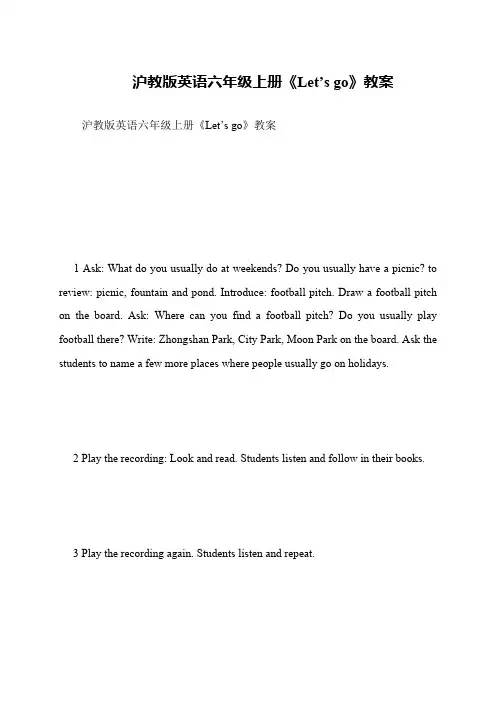
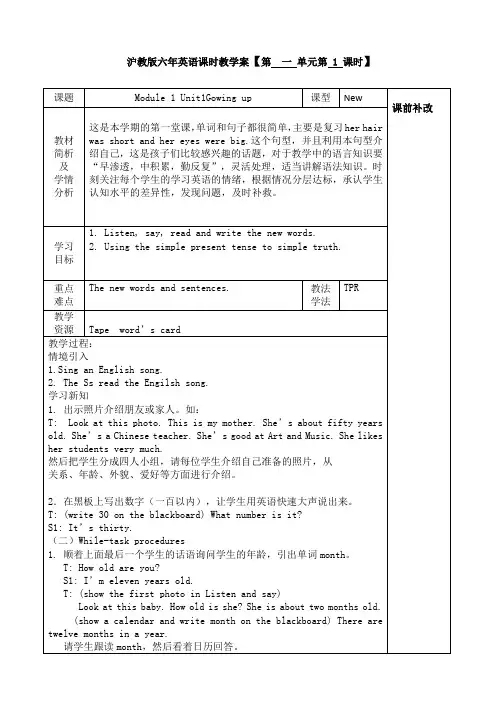
沪教版六年英语课时教学案【第一单元第 1 课时】
(六)年英语课时教学案【第一单元第 2 课时】
( 6 )年英语课时教学案【第 1 单元第 3 课时】
(六)年英语课时教学案【第二单元第 1 课时】
(六)年英语课时教学案【第二单元第 2 课时】
(六)年英语课时教学案【第 2 单元第 3 课时】
(六)年英语课时教学案【第3单元第 1 课时】
( 六 )年英语课时教学案【第 3
单元第 2 课时】
(六)年英语课时教学案【第 3单元第 3 课时】
(六)年英语课时教学案【第 4 单元第 1 课时】
(六)年英语课时教学案【第4单元第 2 课时】
(六)年英语课时教学案【第 4 单元第 3 课时】
(六)年英语课时教学案【第5单元第1课时】
(六)年英语课时教学案【第5单元第2课时】
(六)年英语课时教学案【第5单元第3课时】
(六)年英语课时教学案【第6单元第1课时】
(六)年英语课时教学案【第6单元第2课时】
(六)年英语课时教学案【第6单元第3课时】
(六)年英语课时教学案【第7单元第1课时】
(六)年英语课时教学案【第7单元第2课时】
(六)年英语课时教学案【第7单元第3课时】
(六)年英语课时教学案【第8 单元第第 1 课时】
(六)年英语课时教学案【第8 单元第 2 课时】
(六)年英语课时教学案【第8 单元第3 课时】
(六)年英语课时教学案【第9 单元第 1 课时】。
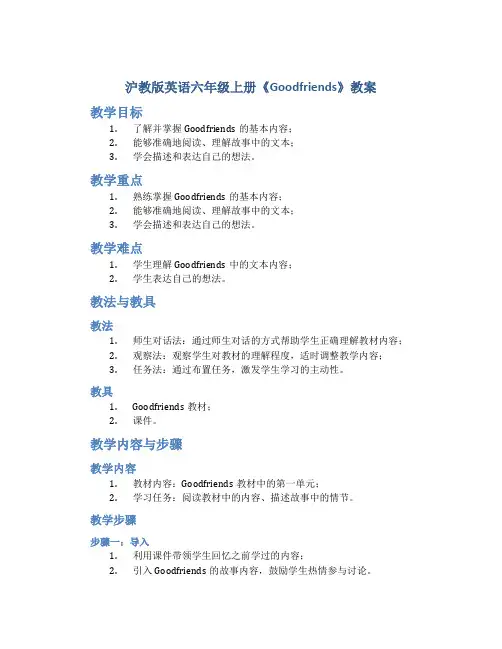
沪教版英语六年级上册《Goodfriends》教案教学目标1.了解并掌握Goodfriends的基本内容;2.能够准确地阅读、理解故事中的文本;3.学会描述和表达自己的想法。
教学重点1.熟练掌握Goodfriends的基本内容;2.能够准确地阅读、理解故事中的文本;3.学会描述和表达自己的想法。
教学难点1.学生理解Goodfriends中的文本内容;2.学生表达自己的想法。
教法与教具教法1.师生对话法:通过师生对话的方式帮助学生正确理解教材内容;2.观察法:观察学生对教材的理解程度,适时调整教学内容;3.任务法:通过布置任务,激发学生学习的主动性。
教具1.Goodfriends教材;2.课件。
教学内容与步骤教学内容1.教材内容:Goodfriends教材中的第一单元;2.学习任务:阅读教材中的内容、描述故事中的情节。
教学步骤步骤一:导入1.利用课件带领学生回忆之前学过的内容;2.引入Goodfriends的故事内容,鼓励学生热情参与讨论。
步骤二:阅读理解1.向学生播放视频或读取文本,让学生全面了解故事情节;2.师生互动:通过师生对话的方式让学生更深入地理解故事内容;3.学生个人阅读:让学生自主阅读故事,加深理解。
步骤三:情境交际1.师生互动:通过师生对话的方式,帮助学生描述故事中的情境;2.任务布置:让学生分组讨论再现故事情节。
步骤四:总结1.总结本堂课教学内容;2.布置下节课内容。
课后作业1.找出自己喜欢的一段Goodfriends中的文本,并通过语音或者视频的方式朗读出来;2.通过互联网查找相关资料,了解中西式早餐的差异。
随堂测试1.请描述Goodfriends中故事情节的主要内容;2.梳理故事情节,画出思维导图。
沪教版英语六年级上册《myhome》教案一、教学目标1.学生能够熟练掌握生活用品的名称,并能够运用所学内容进行简单的交流。
2.培养学生的英语思维能力,提高其英语听说读写各方面的综合能力。
3.能够帮助学生了解并感受家庭的温馨,增强对家庭的归属感和家庭观念。
二、教学重点和难点重点1.生活用品的名称及运用。
2.Before和After的使用。
难点1.生活用品的名称音标的纠正。
2.Before和After的运用及差异。
三、教学方法1.听说结合教学法2.听力练习与口语表达的相结合3.活动教学法4.视觉、听觉、动觉综合教学法四、教学流程1. Warm-up(5分钟)通过自我介绍交流英文名字,几位同学互相介绍,并造句使用一些简单的英语句子。
如:Hi, my name is Lucy. I am a girl. I like singing and dancing.2. Presentation(15分钟)向学生展示生活用品,询问学生是否知道该物品的名称,并让学生学习该物品的单词及发音。
- Step1:展示物品。
- Step2:询问学生该物品的名称,并进行拼读及音标的讲解和练习。
- Step3:师生搭配合作,在小组内互相问答,运用所学生字进行交流。
3. Practice(20分钟)通过活动,让学生交流自己家里的物品及使用场景,帮助学生运用Living room, Bathroom等单元所学进行交流。
- Step1:引导学生观察照片,描述照片中的家居情景。
- Step2:学生自由交流家里的物品及场景,并进行记录。
- Step3:学生进行小组交流,互相了解和比较不同家庭的生活情况。
4. Before-After(10分钟)教授Before和After的用法,理解二者不同,并进行实际运用。
- Step1:教师用图片展示的方式,教授Before和After的用法。
- Step2:运用学生所学,通过问答等活动实际运用。
Module 1 Getting to know each otherUnit 1 Growing up.◆教材分析本课是教材Module 1 Unit 1的教学设计。
本单元的语言功能项目是To talk about the grow up of themselves.主要话题是To think about the ways of know the world,本课内容贴近学生的生活和学习实际,为学生操练对话创设了一个真实的语言情景,有利于学生在比较接近实际的情景中听听说说,从而培养他们运用英语进行交际的能力。
◆教学目标【知识目标】1. To talk about students’ things of grow up.2. To think about the ways of know the world.【能力目标】To use the sentences in context.【情感目标】利用多种游戏或活动形式培养学生对英语学习的浓厚兴趣。
◆教学重难点◆【教学重点】To think about the ways of know the world.【教学难点】通过阅读活动,引导学生通过阅读抓住关键信息,了解故事大意,通过角色扮演,让学生巩固和运用本单元所学核心词汇和句型。
◆课前准备◆Tape recorder, Multimedia◆教学过程Step 1. Lead-inFree talkT: How old are you?How tall are you?Do you remember your height when you first came to this school?Step 2. Listen and readPlay the tape for students to listen and answer.Ask the students to listen to the comic strips and answer the following questions:1.What is on Eddie’s mind?2.Will Eddie build his house by himself?Step 3. PresentationT: You are growing older and taller, so ,you are growing up.What comes into your mind when talking about “growing up”?Encourage the students to talk about the words or sentences about “growing up”?Q: Do you feel happy to grow up?Do you want to grow up?Teacher says: Just like what Eddie said,“Growing up is hard.”Growing up also means that you learn more about the world.How do you learn about the world?Show them some pictures to encourage the students to say out the full sentences and finish Part A.Step 4. PracticeListen to part B.Ask: How does Mill learn about the world? Why?How does Simon learn about the world? Why? Work in pairs to practice the dialogue.Sample conversation :S1: How do you learn about the world?S2: I like to learn about the world from films.S1: Why do you like to learn that way?S2: Because I can see...Step 5. SummaryDiscussion: What have we learned in this class? Show time.1.on one’s mind.2.be worried about(doing).3.Growing up is hard.4.You have been happy since I first met you.5.wake sb. up.6.learn that way.7.through the Internet.8.as soon as.9.a great deal of.Step 6. HomeworkRevise the contents we’ve learned in this period . Recite the comic strip fluently .Finish exercises in workbook for each period.◆教学反思略。
沪教版英语六年级上册《Goodfriends》教案一、教学目标1.知识目标:•学习并掌握基本的单词、短语和句型;•理解并正确使用本课时的关键词汇和句型;•学会描述和谈论身边的人物和事情;2.能力目标:•培养学生积极参与英语教学的能力和兴趣;•通过听、说、读、写、唱等方式,提高学生的英语语言能力;•培养学生团队协作、互相帮助的合作精神;3.情感目标:•培养学生对英语学习的自信心和兴趣;•培养学生的学习态度,知道如何实现自己的目标。
二、教学内容本课程的主要内容是《Goodfriends》,包括以下部分: 1. 单元的重点和难点:* 介绍My good friends; * 学会描写人物; * 掌握简单的口语表达能力。
2. 相应能力的训练: * 听、说、读、唱和写; * 通过听力训练来提高学生对于英语语音的听辨能力; * 通过练习口语来训练学生的口语表达能力; * 通过写作练习来巩固学生的语法和词汇。
三、教学方法1.情境教学法2.演示教学法3.展示教学法4.背景教学法5.情景教学法四、步骤与课时安排第一课时自主学习:1.通过听、说、读、写和唱方式记忆本册课标中My good friends的对话并背诵。
2.阅读课文《My good friends》。
家庭作业:1.熟读课文;2.了解单词及短语的意思;3.正确朗读对话,并背诵。
第二课时教师示范:1.以本册课标的对话为引导,由教师向学生介绍描写人物的方法。
2.在讲述时,教师应注重以下几方面:•感性的描述,引起学生的兴趣;•了解学生的语言水平,并根据学生的表现有所调整;•了解学习目标,有有效的策略。
学生练习:1.以课标的对话为基础,让学生在小组内进行描写人物的练习;2.通过组内合作,让学生提高口语表达能力;3.鼓励学生互相交流,互相帮助,提高团队协作的精神。
家庭作业:1.整理今日的学习内容,做好笔记;2.练习口语表达。
第三课时家庭作业讲解:1.进行朗读口语表达训练;2.讲解疑问句的语法。
沪教版小学英语六年级上册教案沪教版小学英语六年级上册教案1《my home》教材分析:本课时主要是通过展示家庭居室结构,让学生学习各个房间的英文名称study, bathroom, bedroom, living room, kitchen. 家是每个学生最熟悉的地方,学生要学会运用本课所学知识来简单描述自己的家,结合学过的语言描述各个房间。
“Let's do”部分的教学是结合“Let's learn”中所学过的单词进行扩展,让学生知道一些相关单词的指示用语。
让学生在听懂这些用语的基础上,进行模仿和听、做活动。
还可设计多种课堂活动,使学生掌握这一部分的内容,同时激发学生学习英语的兴趣。
教学目标:1.能简单描述自己的房间。
2.能听、说、认读本课主要单词:study, bathroom, bedroom, living room, kitchen,并能在日常生活中运用。
3.能听懂Let's do中的指示语,并按照指令作出相应的动作。
教学重点:1、听、说、认读单词:study, bathroom, living room, bedroom, kitchen。
2、学习表示指令的词组。
教学难点:单词study, bathroom, bedroom的发音。
教学方法:引导法启发法直观教学法学法分析:小组合作学习法讨论学习法自主学习法教学过程:1 Warm-up/Revision教师引导1、集体唱英文儿歌。
2、复习上节课所学单词2 Presentation1、出示study 的图片,手指着书房里的书问学生:What are they? 教读单词 study, 并板书。
教师用动作帮助学生理解词义:We read the books in the study.2、按照相同方法,教授单词 bathroom, living room, bedroom.3、师把第46页Let’s learn部分的挂图贴到黑板上说:This is my home. How many rooms can you see? What are they?4、教师说指令。
学生回答提问:They are books 并跟老师认读study。
学生依次回答问题并跟老师认读单词bathroom, living room, bedroom.学生用动作和语言表达句子,并说出相应的房间。
听录音,跟读Let’s do部分。
3 Practice出示练习题习题练习并拓展教学内容与教师的活动媒体的运用学生的活动教师进行逻辑选择教学评价:1、学生评价:以小组为单位完成老师所提出的问题,然后进行小组交流,组内进行互评。
2、教师评价:教师对完成情况进行适当正确的评价,并给与激励性的语言,手势。
教学反思:通过本节课的学习,学生基本掌握了所学到的新词,熟读且能理解课文内容,并能够运用到实际情景当中,教者能够利用多种教学方法,提高了学生学习的兴趣,达到了预期的效果沪教版小学英语六年级上册教案2《people's jobs》教学内容:1.词汇(1)复习关于职业的词汇:doctor, teacher, nurse, cook, fireman, driver, policeman, pilot, singer.(2)学习生词:astronaut, coach, actor (actress),writer.2.功能句型(1)复习询问他人职业及回答:What does he/she do? He/She is a/an …。
(2)学习询问对方将来想要从事的工作及回答:What do you want to be when you grow up?I want to be a/an …。
教学目标:1.知识目标(1)能掌握和职业相关的一些词汇,并能在相应的功能句型中熟练运用;(2)能在恰当的情景下熟练运用关于询问他人的职业及回答的交际用语;(3)能在相应的情景下熟练地运用关于询问对方将来想要从事的工作及回答的交际用语。
2.能力目标(1)通过学习和操练,使学生能掌握本课所学关于职业的词汇,能熟练询问他人的职业及对将来工作的理想,并做出相应的回答;(2)在学习过程中培养学生发现问题和解决问题的能力,提高自学能力;3.策略目标(1)帮助学生学会与人合作,共同完成学习任务;(2)帮助学生学会观察生活中标的英语,学会借助词典来学习。
4.其他目标(1)在学习职业名称的过程中了解“感动中国的2003年度人物”,潜移默化地为学生树立榜样;(2)在小组学习和帮助他人学习的同时,培养学生乐于助人,热爱集体的良好品质;(3)通过多种形式的游戏和活动,激发学生英语学习兴趣。
教学重点:1.重点词汇:astronaut, coach, actor (actress), writer.2.重点句型:What do you want to be? I want to bea/an …。
教学难点:1.正确朗读和运用关于职业的词汇。
2.正确理解、询问对方对将来工作的理想,并能做出正确的回答。
教具准备:1.教师准备:多媒体课件,图片,单词卡片,奖励卡片;2.学生准备:课本,笔。
教学过程:课前介绍评价方式Step 1: Warm up and lead in1. Oral English2. Sing a song: The Wheels on the Bus.3. (课件): Look, she is the driver of the bus. Her job is driving the bus. Do you know “job”? 板书Jobs,并介绍课题。
Step 2: Review some words1. Free talk: What jobs do you know? (Can you act asa …?)2. Games:(1) Show some word cards, read and act.(2) Act, ask and guess---What does he/she do?Step 3: Presentation:1. Talk about the great people in 2003.(1) Watch the screen and think: Who are they? What are their jobs? (通过课件呈现“感动中国”的人物。
)(2) T: They are called the Great People in 2003. 他们是被评为“感动中国的2003年度人物中的几个。
Do you know their names?(介绍6个人物的姓名。
学生活动:介绍人物姓名,摆放相应人物的复读机、图片和文字介绍材料。
教师示范第一个。
)(3) Watch and listen.T: What are their jobs? Let’s listen. (课件录音完整介绍6个人物的工作和业绩。
)2. Learn the new word by the students themselves.(1)示范pair work: Listen, look, match and read. (示范过程中学习生词:coach---c-oa-ch---coach)(2)学生自学单词,合作完成练习。
T: OK. Boys and girls take out your paper and practice with your partner, please. If there are some new words for you, you can use your dictionary(出示字典), go to listen to the tape or teach each other.(学生活动:自学不会的单词,合作完成练习。
)(3)学生组内练习介绍一个人物。
(学生活动:选择一至两个人物在组内练习介绍。
)3. Introduce them in the front.T: Who wants to e here and introduce one of them to us? Please listen carefully and check your answers.(学生活动:自愿前来介绍一个人物。
)要求:介绍以后要板书图片;离人物介绍大图较近的学生可以引导用大图片。
4. 相应单词的练习astronaut:(1) Pronunciation: astronaut---an astronaut.(2) Practice (Pass the picture and ask) What does he do? He is an astronaut.writer:(1) T: Can you act as a writer? 引导学生练习: writer---writer(2) T: What other writers do you know?actor:(1) T: Who’s your favorite actor? (根据学生的回答介绍:actress)(2) T: Do you want to be an actor or actress? Why?5. Learn the sentence patterns.(1) T: They are all the great people in China. We will always remember them. Do you want to be one of them? What do you want to be when you grow up? You can say: I want to be …。
(出示句卡,带读,板书)(2) T: What about my daughter? Can you ask her?(出示句卡,学习问句,板书) want---want to be---What do you want to be---grow up---when you grow up---What do you want to be when you grow up?(3) 课件:播放录音---妞妞的回答(4) Practice: Pair work; Show in the front.Step 4: Reinforcement --- Talk about the most popular job.T: Excellent! You have so many wonderful dreams for your future job. What is the most popular job in our class? Let’s finish a questionnaire.(1) Model;(2) 小组调查;(3) 各小组填写结果;(4) 汇总全班调查结果T: The most popular job in our class is ________. Why do you want to be a/an …?Step 5: SummaryT: How can you make your dream to be true? What canyou do for your dream?Please remember: Where there is a will, there is a way. (课件呈现)Step 6: HomeworkTalk about your dream job with your parents.沪教版小学英语六年级上册教案3Language focus:Using ‘want to’ to express intentionse.g. I want to have a picnic.Using ‘going to’ to describe events that will occur quite soone.g. I'm going to visit City Park!Pre-task preparation1 Ask: What do you usually do at weekends? Do you usually have a picnic? to review: picnic, fountain and pond. Introduce: football pitch. Draw a football pitch on the board. Ask: Where can you find a football pitch? Do you usually play football there? Write: Zhongshan Park, City Park, Moon Park on the board. Ask the students to name a few more places where peopleusually go on holidays.2 Play the recording: Look and read. Students listen and follow in their books.3 Play the recording again. Students listen and repeat.While-task procedure1 Ask the students to read the information boards in Read and choose. Students work in groups to discuss where all the characters want to go. Distribute a copy of Photocopiable page 17 to help the students make a choice. Invite the more able students to tell the reasons.2 Distribute a copy of Photocopiable page 18 to each student. Students work in groups of five. They are required to discuss what their group are going to doon a holiday. Then each group member has to choose aplace which suits most of the group members. Finally, the group can vote and choose the most suitable place to go.3 Play the recording: Read a poem. Students listen first. Then the whole class follow and read together.4 Encourage the students to rewrite the verses. Distribute a copy of Photocopiable page 19 to each group. Ask them to replace City Park with the place which they would like to visit. Groups take turns to read their poem. The whole class vote for the best reader.Post-task activities1 Workbook page 62 A poemWrite the beginning of the poem on the board: It's (a day) tomorrow. What do you want to do? to elicit: I want to go to ... Continue with: What are you going to do? What are you going to see? Where are you going to eat?。